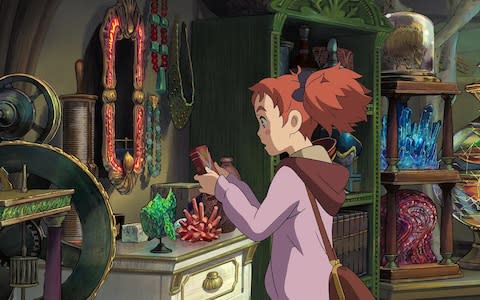Mary and the Witch’s Flower review: brims over with the bounce and spark of childhood

Dir: Hiromasa Yonebayashi; Starring: Ruby Barnhill, Kate Winslet, Jim Broadbent, Louis Ashbourne Serkis, Ewen Bremner, Morwenna Banks, Lynda Baron (voices). U cert, 103 mins.
There’s something about Mary, although she doesn’t yet know it. As far as this restless young girl with a bright thicket of strawberry hair is aware, life has reached a loose end, with a whole summer to fill at her great aunt’s cottage in the village of Red Manor, unpacking her things, exploring the quiet country lanes, and waiting for her parents to arrive.
But in the forest nearby, things are waiting for Mary: an old broomstick entwined in the tendrils of a tree, and a mysterious blue flower called a fly-by-night, which blooms only once every seven years, and whose glowing sap confers magical powers on whoever it touches.
Woods today; big surprise. You get the picture. Yet this outstanding Japanese animation, adapted from the (very English) children’s book The Little Broomstick by Mary Stewart, is a fairy tale quite unlike any other before it.
The pedigree is key. Mary and the Witch’s Flower is the first film from Studio Ponoc, an animation house founded by veterans of the great Studio Ghibli, whose lyrical spins on western children’s fantasy novels, often with headstrong young female leads, were so distinctive they were like a genre unto themselves.
Two of them – Arrietty and When Marnie Was There – were directed by Hiromasa Yonebayashi, and Mary is his first post-Ghibli project. The old studio’s hyperreal house style is very much in evidence, but the images have a more overtly cartoonish elasticity and snap that adds an extra crackle of kinetic energy to every tumble and pursuit.
As in Lewis Carroll’s Alice in Wonderland – or indeed the Ghibli masterpiece My Neighbour Totoro – the path to the magical world is revealed by a little animal: in this case, a black cat called Tib, who appears one lunchtime while Mary (spiritedly voiced by Ruby Barnhill) lazes on the hillside by her great aunt’s house.
And once the flower is discover and the broomstick untangled, it’s a short flight to Endor College, a school for witches and warlocks where Mary is received by the ebullient headmistress Madame Mumblechook (Kate Winslet) and teacher Doctor Dee (Jim Broadbent) as a new star pupil, thanks to the fly-by-night's impressive effects.
Stewart’s book was published in 1971 and predates Harry Potter by some 26 years, but the basic premise of a magical school is an unavoidably familiar one, so Ponoc’s artists and animators have striven to make Endor vibrant and distinctive, with multicoloured minarets, pipework modelled on woodwind instruments, strange things lurking in the topiary and hollow-chested robot golems reminiscent of the sentinels in Ghibli’s own first film, Castle in the Sky. In short: not a gargoyle or cobweb in sight.

In a further dreamlike twist, the place is always either bursting with activity or eerily deserted – but in both states, it teems with the kind of strange details that seem to pose questions rather than answer them, and which you end up turning over in your mind for days. In an oddly similar way, the film’s vision of sleepy rural England is just as arresting: from the sunlit serenity of Great Aunt Charlotte’s garden to a parked car lazily mounted on the pavement of a village street, everything feels mesmerisingly right.
It transpires that Madame Mumblechook and Doctor Dee’s designs on Mary aren’t entirely pedagogical, and she becomes ensnared in a dangerous experiment, along with a boy from Red Manor called Peter (Louis Ashbourne Serkis), and an entire menagerie of surreal hybrid beasts. Escape takes courage and resourcefulness rather than special powers – an admirable narrative staple of the old Ghibli adventures, which Mary proudly carries forward.
Though the film's early scenes have the tranquil texture of a daydream, later on things become heart-racingly intense – not by means of violence and mayhem, but through breathtaking images and vividly expressed emotional stakes. Every feat of imagination is an equal feat of draughtsmanship: that’s the nature of the medium, and perhaps the source of that certain kind of wonder in cinema that only hand-drawn animation can summon up.
This art-form has long been thought to have reached its twilight years, but Yonebayashi’s film brims over with the bounce and spark of childhood.


